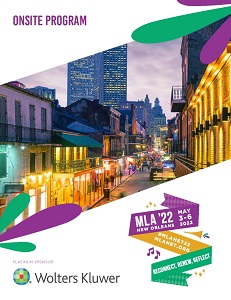Back
Paper: Research Abstract
Information Management
Session: Professionalism & Leadership Session 2
Exploring Library Use as We Returned to "Normal" in Fall 2021: How Different is "Normal" and Why?
Friday, May 6, 2022
3:00 PM – 3:15 PM CT
Location: 354
- RS
Robin Sewell
Interim Associate Director for Client Services
Texas A&M University, Medical Sciences Library
College Station, Texas
Presenter and Author(s)
Objectives: Many universities and their associated libraries returned to normal for the 2021 fall semester. At our university this means face-to-face instruction only, all services fully open, and mask mandates and social distancing requirements are forbidden. Although we are back to normal, the library feels less busy. This analysis uses library data gather from multiple sources pre-pandemic and for the fall 2021 semester to answer four questions on library space use:
Is library space use impacted by the ongoing pandemic?
Have our patron demographics changed?
Why has patron use changed?
Are health sciences students reasons for changes in use different?
Methods: Our library has several data sources that include pre-pandemic library use data and data for Fall 2021. These include Springshare LibCal reservations, swipe access to the graduate study space, Sensource occupancy data, and manual space use counts from fall 2017 and fall 2021 counting projects. The Springshare and swipe access data includes college affiliation information and will speak to changes to the college level demographics of our patrons. This data will be supplemented by a brief six question survey available to patrons using our spaces and sent via a targeted email to health sciences students requesting their participation. The survey will gather information on current library use, pre-pandemic library space use, changes in space use, and the reasons for these changes or for a lack of library space use.
Results: All data sources show a decrease in patron use of MSL spaces (17% - 64%). Demographic data shows minimal changes in the demographics of the patrons using MSL spaces. The predominant reason for decreased students use of MSL space was studying at home (45.5%). There was no difference between health sciences and non-health sciences patrons reasons for not using our spaces in fall 2021.
Conclusions: While space use was impacted by the pandemic, the trend actually began earlier. This is a prime opportunity to emphasize the services of the library, focusing less on the library as a physical space
Is library space use impacted by the ongoing pandemic?
Have our patron demographics changed?
Why has patron use changed?
Are health sciences students reasons for changes in use different?
Methods: Our library has several data sources that include pre-pandemic library use data and data for Fall 2021. These include Springshare LibCal reservations, swipe access to the graduate study space, Sensource occupancy data, and manual space use counts from fall 2017 and fall 2021 counting projects. The Springshare and swipe access data includes college affiliation information and will speak to changes to the college level demographics of our patrons. This data will be supplemented by a brief six question survey available to patrons using our spaces and sent via a targeted email to health sciences students requesting their participation. The survey will gather information on current library use, pre-pandemic library space use, changes in space use, and the reasons for these changes or for a lack of library space use.
Results: All data sources show a decrease in patron use of MSL spaces (17% - 64%). Demographic data shows minimal changes in the demographics of the patrons using MSL spaces. The predominant reason for decreased students use of MSL space was studying at home (45.5%). There was no difference between health sciences and non-health sciences patrons reasons for not using our spaces in fall 2021.
Conclusions: While space use was impacted by the pandemic, the trend actually began earlier. This is a prime opportunity to emphasize the services of the library, focusing less on the library as a physical space

.png)

